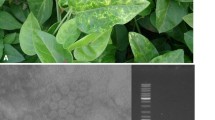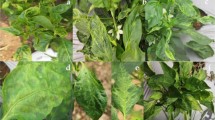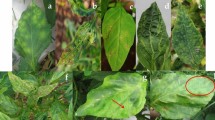Abstract
Plectranthus barbatus also known by the synonym Coleus forskohlii it is called as forskohlii and Indian coleus. It is a tropical perennial herb belongs to the family Lamiaceae widely cultivated in India used as traditional medicinal crop. Its tuberous roots produce forskolin, an extract useful for pharmaceutical preparations and research in cell biology. The incidence of mosaic with dark and light green patches, mottling, leaf distortion and reduction growth was noticed in commercial cultivation of coleus. For identification of the virus, the infected leaf sample extract was mechanically inoculated to different hosts such as chilli, tobacco, tomato, cucumber, cowpea and Chenopodium amaranticolor. Host range studies revealed that the virus showed severe mosaic symptoms on Nicotiana spp. and Cucumis spp. The virus produced systemic and local lesion symptoms in a different host. The Leaf dip preparation of virus infected leaf extract was observed under an electron microscope showed the presence of isometric particles of 28 nm in size. The healthy and infected samples were tested using DAC-ELISA against antibodies of CMV, GBNV and TSV the infected samples showed strong positive reaction with 1.85 optical density to CMV antibodies indicated the presence of CMV. For molecular identification, total RNA was isolated and used for RT-PCR amplification using CMV specific primers. RT-PCR resulted in the positive amplification in virus infected samples but not from a healthy control. The complete genome of CMV RNA-1 consists of 3360 nucleotides (nt) encoding replicase gene of 807 amino acids (aa). The CMV RNA-2 was 2983 nt in length containing 2a (859 aa) encoding RNA dependent RNA polymerase protein and 2b encoding viral silencing suppressor (112 aa), while RNA-3 encoding 3a movement protein (280 aa) and coat protein (219 aa) was 2223 nt in length. Phylogenetic analyses of nucleotide sequences of coleus CMV isolate is closely related to subgroup IB than to subgroup IA or II with other CMV isolates. In recombination analysis, the recombination event occurs between the subgroups of I, II as well as IA and IB in RNA 1, RNA2 and RNA3 of coleus isolate with other CMV isolates. To best of our knowledge, this is the first report of CMV infection in coleus.




Similar content being viewed by others
References
Acosta-Leal R, Duffy S, Xiong Z, Hammond RW, Elena SF. Advances in plant virus evolution: translating evolutionary insights into better disease management. Phytopathology. 2011;101:1136–48.
Afreen B, Khan AA, Naqvi QA, Kumar S, Pratap D, Snehi SK, Raj SK. Molecular identification of a Cucumber mosaic virus subgroup II isolate from carrot (Daucus carota) based on RNA3 genome sequence analyses. J Plant Dis Prot. 2009;116:193–9.
Hasiow-Jaroszewska B, Budzynska D, Rymelska N, Korpys P, Borodynko-Filas N. Phylogenetic evidence of natural reassortants in the Cucumber mosaic virus population in Poland. Can J Plant Pathol. 2018;40(4):587–93.
Bonnet J, Fraile A, Sacrista S, Malpica JM, Garcı Arenal F. Role of recombination in the evolution of natural populations of Cucumber mosaic virus, a tripartite RNA plant virus. Virology. 2005;332:359–68.
Canto T, Prior DAM, Hellwald KH, Oparka KJ, Palukaitis P. Characterization of Cucumber mosaic virus. IV. Movement protein and coat protein are both essential for cell-to-cell movement of Cucumber mosaic virus. Virology. 1997;237:237–48.
Davino S, Panno S, Rangel EA, Davino M, Bellardi MG, Rubio L. Population genetics of Cucumber mosaic virus infecting medicinal, aromatic and ornamental plants from northern Italy. Arch Virol. 2012;157:739–45.
Diveki Z, Salanki K, Balazs E. The necrotic pathotype of the Cucumber mosaic virus (CMV) Ns strain is solely determined by amino acid 461 of the 1a protein. Mol Plant Microbe Int. 2004;17(8):837–45.
Dubey VK, Aminuddin Singh VP. Molecular characterization of Cucumber mosaic virus infecting Gladiolus, revealing its phylogeny distinct from the Indian isolate and alike the Fny strain of CMV. Virus Genes. 2010;41:126–34.
Garcia-Arenal F, Escriu F, Aranda MA, Alonso-Prados JL, Malpica JM, Fraile A. Molecular epidemiology of Cucumber mosaic virus and its satellite RNA. Virus Res. 2000;71:1–8.
Gautam KK, Kuma S, Raj SK. Molecular characterization of Cucumber mosaic virus strain causing severe mosaic disease on petunia. Phytoparasitica. 2012;40(5):425–31.
Gautam KK, Raj R, Kumar S, Raj SK, Roy RK, Katiyar R. Complete sequence of RNA3 of Cucumber mosaic virus isolates infecting Gerbera jamesonii suggests its grouping under IB subgroup. Virus Dis. 2014;25:398–401.
Geetanjali SA, Kumar R, Srivastava PS, Mandal B. Biological and molecular characterization of two distinct tomato strains of Cucumber mosaic virus based on complete RNA3 genome and subgroup specific diagnosis. Indian J Virol. 2011;22:117–26.
Gibbs MJ, Armstrong JS, Gibbs AJ. Sister-scanning: a Monte Calro procedure for assessing signals in recombinant sequences. Bioinformatics. 2000;16:573–82.
Hareesh PS, Madhubala R, Bhat AI. Characterization of Cucumber mosaic virus infecting Indian long pepper (Peper longum L.) and betel vine (Piper betle L.) in India. Indian J Biotechnol. 2006;5:89–93.
Hasiow-Jaroszewska B, Chrzanowski M, Budzyńska D, Rymelska N, Borodynko Filas N. Genetic diversity, distant phylogenetic relationships and the occurrence of recombination events among Cucumber mosaic virus isolates from zucchini in Poland. Arch Virol. 2017;162:1751–6.
Jorda C, Alfaro A, Aranda MA, Moriones E, Garcia-Arenal F. Epidemic of Cucumber mosaic virus plus satellite RNA in tomatoes in eastern Spain. Plant Dis. 1992;76(4):363–6.
Khan AA, Sharma R, Afreen B, Naqvi QA, Kumar S, Snehi SK, Raj SK. Molecular identification of a new isolate of Cucumber mosaic virus subgroup II from basil (Ocimum sanctum) in India. Phytoparasitica. 2011;39(2):199–203.
Khan S, Jan AT, Aquil B, Haq QMR. Coat protein gene based characterization of Cucumber mosaic virus isolates infecting banana in India. J Phytol. 2011;3:94–101.
Kim MK, Kwak HR, Jeong SG, Ko SJ, Lee SH, Kim JS, Kim KH, Choi JK, Choi HS, Cha BJ. Characteristics of Cucumber mosaic virus Infecting Zucchini in Korea. Plant Pathol J. 2010;26(2):139–48.
Kim MK, Jeong RD, Hae-Ryun Kwak HR, Lee SH, Jeong-Soo Kim JS, Kim KH, Byeongjin Cha B, Choi HS. First Report of Cucumber mosaic virus Isolated from Wild Vigna angularis var. nipponensis in Korea. Plant Pathol J. 2014;30(2):200–7.
Kim MK, Seo JK, Kwak HR, Kim JS, Kim KH, Cha BJ, Choi HS. Molecular genetic analysis of Cucumber mosaic virus populations infecting pepper suggests unique patterns of evolution in Korea. Phytopathology. 2014;104:993–1000.
King AM, Adams MJ, Carstens EB, Lefkowitz EJ. Genus cucumovirus, virus taxonomy: ninth report of the International Committee on Taxonomy of Viruses, vol. 9. Amsterdam: Elsevier; 2012. p. 970–2.
Koundal V, Haq QMR, Praveen S. Characterization, genetic diversity, and evolutionary link of Cucumber mosaic virus strain New Delhi from India. Biochem Genet. 2011;49:25–38.
Kumar S, Gautam KK, Raj SK. Molecular identification of Cucumber mosaic virus isolates of subgroup IB associated with mosaic disease of eggplant in India. Virus Dis. 2014;25:129–31.
Kumar S, Gautam KK, Raj SK. Sequence analysis and genetic diversity of five new Indian isolates of Cucumber mosaic virus. Acta Virol. 2015;59:398–404.
Kumari R, Bhardwaj P, Singh L, Zaidi AA, Hallan V. Biological and molecular characterization of Cucumber mosaic virus subgroup II isolate causing severe mosaic in cucumber. Indian J Virol. 2013;24(1):27–34.
Lee JA, Choi SK, Yoon JY, Hong JS, Ryu KH, Lee SY, Choi JK. Variation in the pathogenicity of lily isolates of Cucumber mosaic virus. Plant Pathol J. 2007;23(4):251–9.
Lin HX, Rubio L, Smythe A, Jiminez M, Falk BW. Genetic diversity and biological variation among California isolates of Cucumber mosaic virus. J Gen Virol. 2003;84:249–58.
Lin HX, Rubio L, Smythe AB, Falk BW. Molecular population genetics of Cucumber mosaic virus in California: evidence for founder effects and reassortment. J Virol. 2004;78:6666–75.
Miftakhurohmah MM, Wahyuno D. Molecular characterization of Cucumber mosaic virus infecting wild betel (Piper sarmentosum). Curr Sci. 2017;112(12):2369–71.
Mollov DS, Hayslett MC, Eichstaedt KA, Beckman NG, Daughtrey ML, Lockhart BE. Identification and characterization of a carlavirus causing veinal necrosis of coleus. Plant Dis. 2007;91:754–7.
Nagendran K, Priyanka R, Aravintharaja R, Balaji CG, Prashant S, Basavaraj B, Mohankumar S, Karthikeyan G. Characterization of Cucumber mosaic virus infecting snake gourd and bottle gourd in India. Physiol Mol Plant Pathol. 2018;103:102–6.
Nouri S, Arevalo R, Falk BW, Groves RL. Genetic structure and molecular variability of Cucumber mosaic virus isolates in the United States. PLoS ONE. 2014;9(5):e96582.
Owens J, Shintaku M, Aeschleman P, Tahar SF, Palukaitis P. Nucleotide sequence and evolutionary relationships of Cucumber mosaic virus (CMV) strains, CMV RNA 3. J Gen Virol. 1990;71:2243–9.
Palukaitis P, García-Arenal F. Cucumoviruses. Adv Virus Res. 2003;62:241–323.
Palukaitis P, Roossinck MJ, Dietzgen RG, Francki RIB. Cucumber mosaic virus. Adv Virus Res. 1992;41:281–348.
Pratap D, Kumar S, Snehi SK, Raj SK. Biological and molecular characterization of Cucumber mosaic virus isolate causing shoestring disease of tomato in India which has closer affinity to European or East Asian isolates of CMV. Indian J Virol. 2012;23(1):57–63.
Raj SK, Kumar S, Snehi SK. First Report of Cucumber mosaic virus on Jatropha curcas in India. Plant Dis. 2008;92:171.
Raj SK, Snehi SK, Kumar KV, Gautam Khan MS. First report of association of Cucumber mosaic virus with blister and leaf distortion of castor bean (Ricinus communis) in India. Phytoparasitica. 2010;38(3):283–9.
Roossinck MJ. Evolutionary history of Cucumber mosaic virus deduced by phylogenetic analyses. J Virol. 2002;76:3382–7.
Roossinck MJ, Zhang L, Hellwald KH. Rearrangements in the 5′ nontranslated region and phylogenetic analyses of Cucumber mosaic virus RNA 3 indicate radial evolution of three subgroups. J Virol. 1999;73:6752–8.
Sambrook J, Russell DW. Molecular cloning. A laboratory manual, vol. I, II, II. 3rd ed. New York: Cold Spring Harbor Laboratory Press; 2001.
Sharma A, Mahinghara BK, Singh AK, Kulshrestha S, Raikhy G, Singh L, Verma N, Ram R, Zaidi AA. Identification, detection and frequency of Lily viruses in northern India. Sci Hortic. 2005;106:213–27.
Singh AG, Poudyal KN, Tewari DD. Diversity of cultivated and wild medicinal plants used by people of Devdaha VDC of Rupandehi district, Western Nepal. Curr Bot. 2011;2(2):34–42.
Srivastava A, Raj SK. High molecular similarity among Indian isolates of Cucumber mosaic virus suggests a common origin. Curr Sci. 2004;87:1126–31.
Srivastava KM, Raj SK, Singh BP. Properties of a Cucumber mosaic virus strain naturally infecting Chrysanthemum in India. Plant Dis. 1992;76:474–6.
Sudhakar N, Nagendra-Prasad D, Mohan N, Murugesan K. First report of Cucumber mosaic virus subgroup II infecting Lycopersicon esculentum in India. Plant Dis. 2006;90:1457.
Tamura K, Dudley J, Nei M, Kumar S. MEGA4: molecular evolutionary genetics analysis (MEGA) software version 4.0. Mol Biol Evol. 2007;24(8):1596–9.
Valdes LJ, Mislankars SG, Paul AG. Coleus barabatus (Lamiaceae) and the potential new drug forskolin (Colenol). Eco Bot. 1987;41:474–83.
Verma N, Singh AK, Singh L, Kulshrestha S, Raikhy G, Hallan V, Raja R, Zaidi AA. Occurrence of Cucumber mosaic virus in Gerbera jamesonii in India. Plant Dis. 2004;88:1161.
Verma N, Singh L, Singh AK, Kulshrestha S, Raikhy G, Hallan V, Ram R, Zaidi AA. Ornithogalum: a new host of Cucumber mosaic virus (CMV) from India. Plant Pathol. 2005;54:256.
Verma N, Mahinghara VK, Ram R, Zaidi AA. Coat protein sequence shows that Cucumber mosaic virus isolate from Geranium (Pelargonium spp.) belongs to subgroup II. J Biosci. 2006;31:47–54.
Vishnoi R, Kumar S, Raj SK. Molecular characterization of a Cucumber mosaic virus isolate associated with mosaic disease of banana in India. Phytoparasitica. 2013;41:545–55.
Wang HY, Zhang HR, Du ZY, Zeng R, Chen J. Evolutionary characterization of two Cucumber mosaic virus isolates infecting Pinellia ternata of Araceae family. 2009. http://en.paper.edu.cn/en_releasepaper/content/29724.
Acknowledgements
This work carried under ICAR-CRP on vaccines and diagnostic project the authors are thankful for the financial support. First Author also thank to Director, Head, Division of plant pathology IIHR, Bengaluru for providing laboratory facility for conducting experiments.
Author information
Authors and Affiliations
Corresponding author
Additional information
Publisher's Note
Springer Nature remains neutral with regard to jurisdictional claims in published maps and institutional affiliations.
Electronic supplementary material
Below is the link to the electronic supplementary material.
Rights and permissions
About this article
Cite this article
Pavithra, B.S., Govin, K., Renuka, H.M. et al. Characterization of cucumber mosaic virus infecting coleus (Plectranthus barbatus) in Karnataka. VirusDis. 30, 403–412 (2019). https://doi.org/10.1007/s13337-019-00536-3
Received:
Accepted:
Published:
Issue Date:
DOI: https://doi.org/10.1007/s13337-019-00536-3




